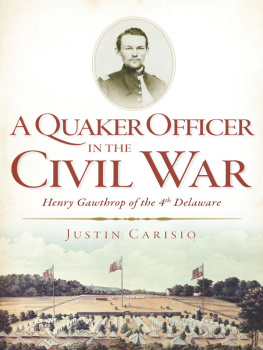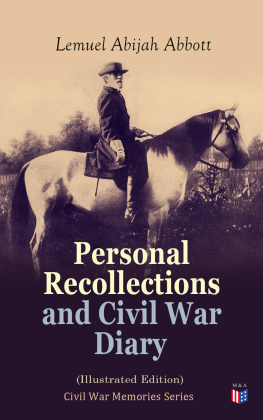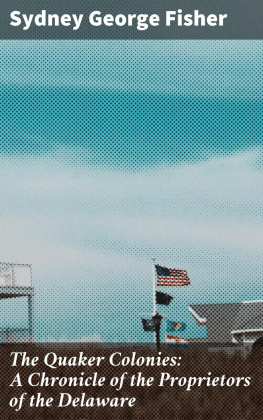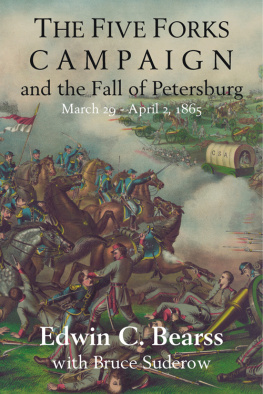
Published by The History Press
Charleston, SC 29403
www.historypress.net
Copyright 2013 by Justin Carisio
All rights reserved
Cover images: Portrait of Henry Gawthrop in October 1862. Daniel H. Kent Collection; Camp Du Pont, 4th Regiment Delaware Infantry. Courtesy of Hagley Museum and Library.
First published 2013
e-book edition 2013
ISBN 978.1.62584.008.0
Library of Congress CIP data applied for.
print edition ISBN 978.1.60949.751.4
Notice: The information in this book is true and complete to the best of our knowledge. It is offered without guarantee on the part of the author or The History Press. The author and The History Press disclaim all liability in connection with the use of this book.
All rights reserved. No part of this book may be reproduced or transmitted in any form whatsoever without prior written permission from the publisher except in the case of brief quotations embodied in critical articles and reviews.
In memory of
First Sergeant Edward D. Gaylord
Company F, 4th Delaware Regiment Volunteer Infantry
Contents
Preface
Henry Gawthrop was a commissioned officer in the 4th Delaware Regiment Volunteer Infantry. He began as a lieutenant in Company F when the regiment was formed in 1862 and later served as a brigade staff officer, rising to the rank of brevet major. He was wounded three times. The last wound, sustained at Five Forks, resulted in the amputation of his right foot.
Five decades after the war, as an elderly veteran living in Swarthmore, Pennsylvania, Gawthrop wrote a book covering his wartime experience from September 1, 1862, to February 1, 1866. Gawthrops text is not a conventional prose memoir. Rather, it is a digest of his wartime correspondence and Army diaries, which he compiled, edited and wrote out as a narrative. The book was created with considerable care. The narrative, written double-spaced, links excerpts from his original diary and letters. The excerpts are, for contrast, rendered single-spaced. His penmanship is a confident and steady cursive. As the reader goes through the book, the text is always on the left-hand page, with the right-hand page usually blank. The book is professionally bound by hand with glossy black end papers and a black leather, semi-rigid cover, front and back. The spine is stamped in gold and reads:
DIARIES AND LETTERS
H.G.
18621866
1915

A page from Diary and Letters illustrates how Gawthrop used spacing between lines and indentation to distinguish between his narrative (top half of the page) and the verbatim excerpts he copied from his wartime letters and diaries (lower half of the page). Courtesy of the Delaware Historical Society.
An inscription on the first page says the book was donated to the Historical Society of Delaware by the niece and nephews of Henry Gawthropchildren of his brother, Joseph Newlin Gawthropon November 17, 1937. The title page shows the title as Diary and Letters.
The more than three hundred handwritten pages are divided into twenty-one chapters, each with a title and a synopsis. Bound within the pages are four photographs, each protected with a sheet of onionskin paper. Three of the pictures are of Gawthrop. The fourth photograph is Gawthrops fellow officer First Lieutenant Richard Henry Webb. Webb and Gawthrop were close friends. Webb was the 4th Delawares first officer to be killed in action. Gawthrops inclusion of the photograph in his book half a century after Webbs death is touching and poignant.
In addition to the photographs, the book contains six hand-drawn maps in black ink. Various movements of the regiment are indicated in red ink, with specific locations labeled alphabetically and keyed to a description in the text. There are also a few diagrams of camp and garrison layouts and some rudimentary drawings.
His original letters and diaries lay for half a century in a small wooden box pierced with a bullet hole that he picked up after the fight at Squirrel Level Road near Petersburg in 1864. The box served as a storage container for his documents until he began his memoir during the winter of 191314 at the urgings of family and as war was looming in Europe. Without those documents, we cannot determine to what extent Gawthrop redacted the passages he presents to us as verbatim quotations from his letters and diaries. Accordingly, his work presents challenges to the reader. Does the book represent selective editing, imperfect recall or interpolations by an elderly man presenting the less-guarded writing of his youth? A comparison with the letters of his friend Richard Webb offers a contrast. Even allowing for what must have been differences in personality between the ebullient Webb and the reserved Gawthrop, Webbs letters from 1862 until his battlefield death in 1864 are fresh, effusive and judgmental. When Gawthrop covers the same ground in his letters, the renditions are careful and reflective.
In any case, we have the book Gawthrop wanted us to have, and it must stand on its own merits. Throughout, Gawthrop comes across as honest, self-effacing and earnest. He allows that his book is but one copy and if read at all will be by near friends. Ironically, Gawthrop could not have foreseen his books most important distinction: diaries and collections of letters from other Delaware soldiers have been preserved, but an autobiographical memoir by a Civil War veteran from Delaware is a rarity. Nearly a century after its creation, Henry Gawthrops Diary and Letters presents a soldiers story and an invaluable insight into the life of one of Delawares fighting regiments. Delaware history is richer for it.
A NOTE ON CITATIONS: This is a book about a book. Of necessity, it relies on Henry Gawthrops Diary and Letters for overall structure, flow and narrative content. Unless otherwise noted, Gawthrops manuscript is the source of information related to his personal experiences and to those of the soldiers of the 4th Delaware Regiment. To minimize endnotes, citations of Gawthrops text are made only after verbatim quotations and by inline notation. Where a number appears inside parentheses at the end of a quotation or paragraph, it refers to the source page in Gawthrops manuscript.
The Delaware Historical Society has granted permission to the author to use extensive quotations from Gawthrops work.
Acknowledgements
Current and former staff members of the Delaware Historical SocietyDr. Constance J. Cooper, Ellen Rendle, Ed Richi and Heather Isbell Schumacherprovided tremendous assistance through their knowledge, guidance and kindness during my many years of research there. I benefitted from the valuable suggestions and corrections of historians Lucas Clawson and John David Hoptak, who read my manuscript. Chris Bryce and Tracy Chernault of the National Park Service reviewed and commented on the chapters that treat the Siege of Petersburg and the Battle of Five Forks. Genealogist James Moore uncovered details of Henry Gawthrops life that otherwise would have eluded me. Andy McKay enlightened me on Civil Warera photography in Delaware. I thank all of them for their time and expertise.
I also thank Richard E. Poole for access to images from the Daniel H. Kent Collection of cartes de visite and Dr. George J. ONeill for the texts of the ONeill letters. Jerre Garrett graciously shared her transcriptions of the articles in the
Next page







